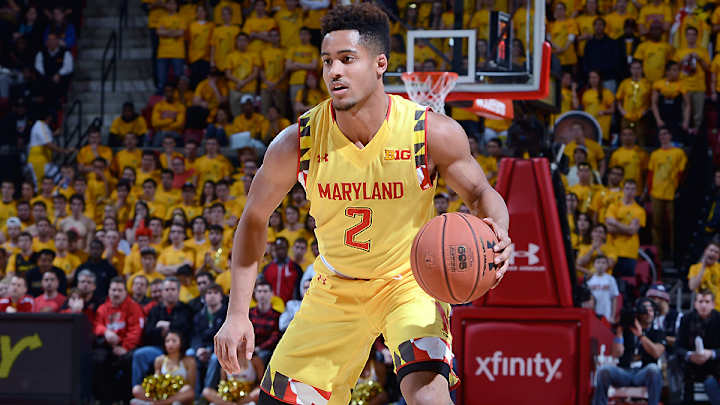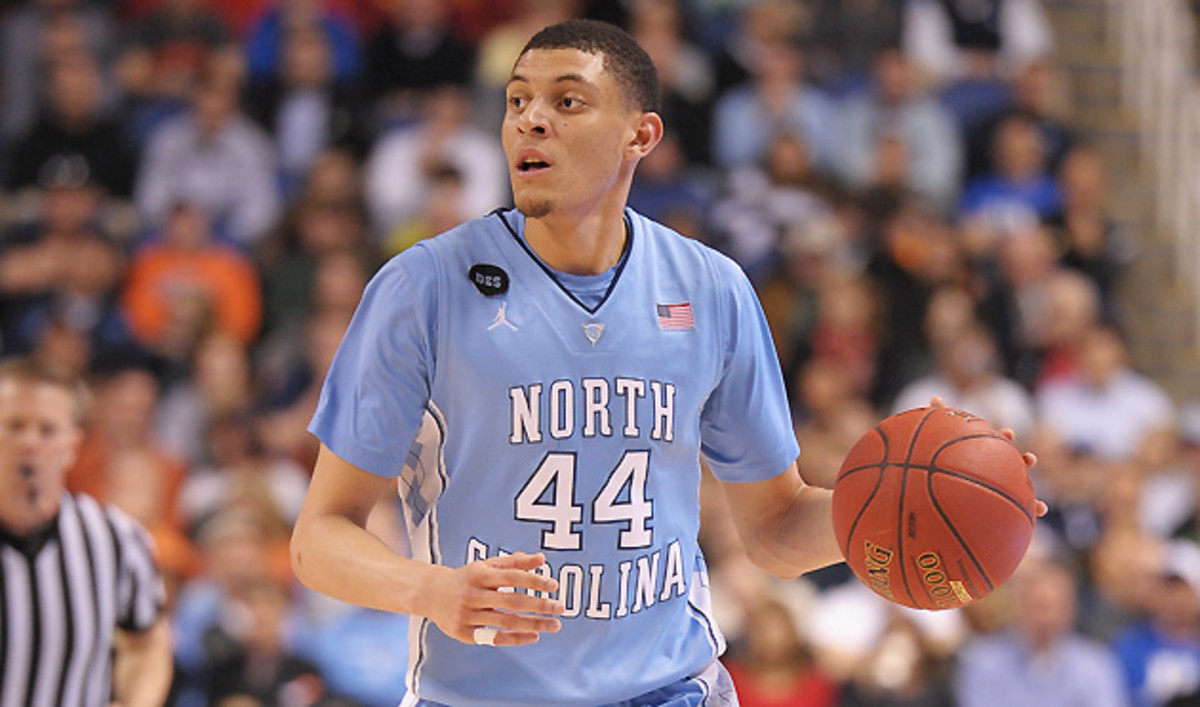Predicting the top 10 high-impact sophomores for 2015-16

Many of the nation’s top recruits spend one season in college before declaring for the NBA draft. But there are always a number of talented holdovers—from players who felt they weren’t quite ready to enter the professional ranks to others with four-year college trajectories. Many make sizeable leaps in production between their first and second campaigns. The list of 10 below has a simple goal—to project which 10 sophomores will make the biggest impact in 2015-16. You may be more familiar with these names than the group of incoming freshmen highlighted in our first installment of the series.
1. Melo Trimble, guard, Maryland
When he leaves College Park—possibly in less than a year—Trimble will be remembered as one of the most important recruits of coach Mark Turgeon’s first three years on the job. A four-star prospect in the class of 2014, Trimble helped the Terrapins overcome the loss of five players to transfer last off-season and earn their first NCAA tournament berth since 2010. Among Big Ten freshmen last season, Trimble ranked first in offensive rating, true shooting percentage, free throws attempts and free throw percentage. What will he do for an encore? After spending part of the summer playing in an international tournament you probably didn’t pay much attention to, Trimble will run the point for a team that likely will enter the season in the top five of most major polls thanks in part to the addition of two impact transfers, Duke’s Rasheed Sulaimon and Georgia Tech’s Robert Carter, and the top center in the class of 2015, Diamond Stone.
2. Jakob Poeltl, center, Utah
Predicting the top 10 high-impact freshmen for 2015-16
Had he decided to enter the draft after last season, Poeltl likely would have been selected in the first round. His return positions the Utes to make the NCAAs for the second consecutive year and compete with Arizona, Oregon, Cal and others at the top of the Pac-12. Poeltl excels as a rebounder, shot-blocker and short-range finisher. Against Pac-12 competition last season, the Vienna, Austria, native pulled down a higher percentage of his team’s missed shots than any other player in the conference and ranked fifth in the conference by swatting seven percent of opponents’ two-point field goal attempts. Poeltl’s offensive repertoire is a work in progress, but his ability to score around the basket, prevent opponents from doing the same and create second chances will help Utah maintain one of the top offenses in the Pac-12. The Utes finished second in the conference (behind Arizona) in adjusted offensive efficiency during league play last season, according to kenpom.com.
3. Grayson Allen, guard, Duke
Whatever Allen accomplishes the rest of his college career—which could last only one more season, given that he may have been a first-round pick in 2015—he will forever be remembered for the scoring spurt that sparked the second-half comeback that led Duke over Wisconsin in the national title game. Despite being Rivals.com’s 28th-best player in 2014 and participating in the McDonald’s All-American game, Allen was relatively unknown to fans outside Durham before he viciously dunked against Michigan State in the Final Four. Allen won’t surprise anyone in 2015-16. The Blue Devils will need him to anchor a backcourt that loses Quinn Cook to graduation and Tyus Jones to the NBA but returns junior Matt Jones and welcomes in highly touted freshmen Luke Kennard and Derryck Thornton.
4. Tyler Ulis, guard, Kentucky
Kentucky’s perimeter rotation will be crowded in 2015-16 even though three of its top guards—Andrew and Aaron Harrison and Devin Booker—left for the draft. The Wildcats welcome in Isaiah Briscoe and Jamal Murray, two point guard recruits assigned five-star ratings by Rivals.com. Where does that leave Ulis? Kentucky won’t ask the 5’9”, 155-pound sophomore to serve as one of its primary scorers, but he’s invaluable because no one else on the roster can match his distribution skills. Last season he led the Wildcats with a 27.2 assist rate while posting the second-highest offensive rating on the team—behind only top draft pick Karl-Anthony Towns. It’ll be interesting to see how John Calipari sorts out backcourt minutes between Ulis, Briscoe and Murray. All three could play together, with Ulis facilitating while Briscoe and/or Murray focus on scoring. In any case, the Wildcats are in good shape with Ulis running the offense.
• MORE: Trevon Duvall could be the best point guard in high school
5. Domantas Sabonis, forward, Gonzaga
Gonzaga would have featured one of the top frontcourts in the country in 2015-16 even if Sabonis had decided to go pro after a promising freshman season. Senior Kyle Wiltjer is a national player of the year candidate who poses matchup problems on the perimeter, while the 7’1”, 288-pound Przemek Karnowski is a skilled passer and scorer in the post. Sabonis adds a different dimension. He’s a voracious glass cleaner—ranking first and fifth, respectively, in the West Coast Conference in defensive and offensive rebounding percentage, according to kenpom.com—and an efficient finisher on the blocks, converting more than 75% of his attempts at the rim, per hoop-math.com. The son of former Portland Trail Blazers center Arvydas Sabonis, Domantas could hear his name called in the first round of next year’s draft. But first, expect him to lead Gonzaga to at least 30 wins, another conference title and a top-four seed in the NCAAs.

6. Justin Jackson, forward, North Carolina
Jackson was the most highly regarded recruit in a class that also featured two other top-30 prospects in small forward Theo Pinson and point guard Joel Berry. A native of Tomball, Tex., Jackson impressed with his advanced offensive game and earned significant minutes right away. Though he struggled at certain points during conference play, his performance trended upward near the end of the regular season and into the tourney. That raised expectations for what he can accomplish as a sophomore. The Tar Heels will lean on point guard Marcus Paige and big men Bryce Johnson and Kennedy Meeks for offense, but opposing teams won’t be able to neglect Jackson. During ACC play last season, he converted a higher percentage of his twos than every Tar Heel but Johnson and also ranked in the top 20 in the conference in effective field goal percentage. Next March, Jackson could be one of the top scoring threats on a team competing for a conference championship and No. 1 seed in the NCAA tournament.
7. James Blackmon Jr., guard, Indiana
Indiana could boast the top offense in the country next season. On any given possession, the Hoosiers will be able to A) direct projected draft pick Troy Williams to attack the basket, B) feed talented freshman center ThomasBryant in the post or C) swing the ball around the arc until a clean shot materializes for one of the six players who connected on more than 38% of their threes last season. That group includes Blackmon, who ranked second among Big Ten freshmen in effective field goal percentage and offensive rating while leading Indiana in usage rate. The returns of Williams and senior point guard Yogi Ferrell could detract from Blackmon’s aggregate scoring numbers, but the attention defenses will devote to those two players could give Blackmon more space to launch from deep. And even if Blackmon doesn’t make a huge statistical leap, the threat he poses on the perimeter will force concessions in coverage elsewhere.
8. Trevon Bluiett, guard/forward, Xavier
Inside DeAndre Ayton's rise from the Bahamas to 2017's No. 1 prospect
Bluiett arrived at Xavier last season ranked 34th among players in the class of 2014, according to Rivals.com, after averaging more than 36 points and 11 rebounds as a senior at Park Tudor (Ind.) School. It didn’t take long for him to show why the lofty preseason expectations were warranted. Bluiett scored 90 points combined on 65% shooting over his first five games and, during conference play, became such an important piece of Xavier’s perimeter rotation that he logged a higher percentage of available minutes than everyone other than sophomore guard Myles Davis, according to kenpom.com. Bluiett was named to the Big East all-rookie team and helped the Musketeers reach the finals of the Big East tournament and win two games in the NCAAs. He should play even more minutes while shouldering a bigger scoring load this season with both senior guard Dee Davis and second-team conference forward Matt Stainbrook moving on this off-season.
9. Wade Baldwin IV, guard, Vanderbilt
If two players from the same team could be counted as one, Baldwin would be joined by fellow Commodores guard Riley LaChance. But even though both performed well during their respective first seasons in college, Baldwin has the potential to develop into a better player down the road. (DraftExpress currently projects the 6’3”, 194-pounder as an early second-round pick in the 2017 draft). Here’s betting that Baldwin creates some separation as a sophomore while helping Vanderbilt make a run at an NCAA berth. In 2014-15, he connected on 43.9% of his three-point shots, led all Commodores in steal rate and recorded a higher assist rate than any teammate who averaged at least 20 minutes per game. Vanderbilt fans will hope that Baldwin’s strong run at the end of the regular season—13.8 points per game on 55.8% shooting over six games—was a preview of what he can deliver as a sophomore.
10. Isaac Copeland, forward, Georgetown
The centerpiece of a heralded five-man recruiting class, Copeland showed up in Washington D.C. last year as Rivals.com's No. 23 player in the class of 2014. Though he endured some rough patches last season, Copeland hinted at his potential to develop into one of the top stretch forwards in the country. He dropped 34 points and grabbed 12 rebounds over two consecutive games against Villanova and Marquette in January and recorded 44 points and 24 boards combined during a three-game winning streak the next month to help Georgetown finish tied for second place in the Big East standings and earn a No. 4 seed in the NCAAs after they missed the field the previous year. There should be more minutes and possessions available for Copeland (and other Georgetown players) in 2015-16 with center Josh Smith, who led the Hoyas with a 28.3 usage rate, and forward Mikael Hopkins departing in the off-season.
